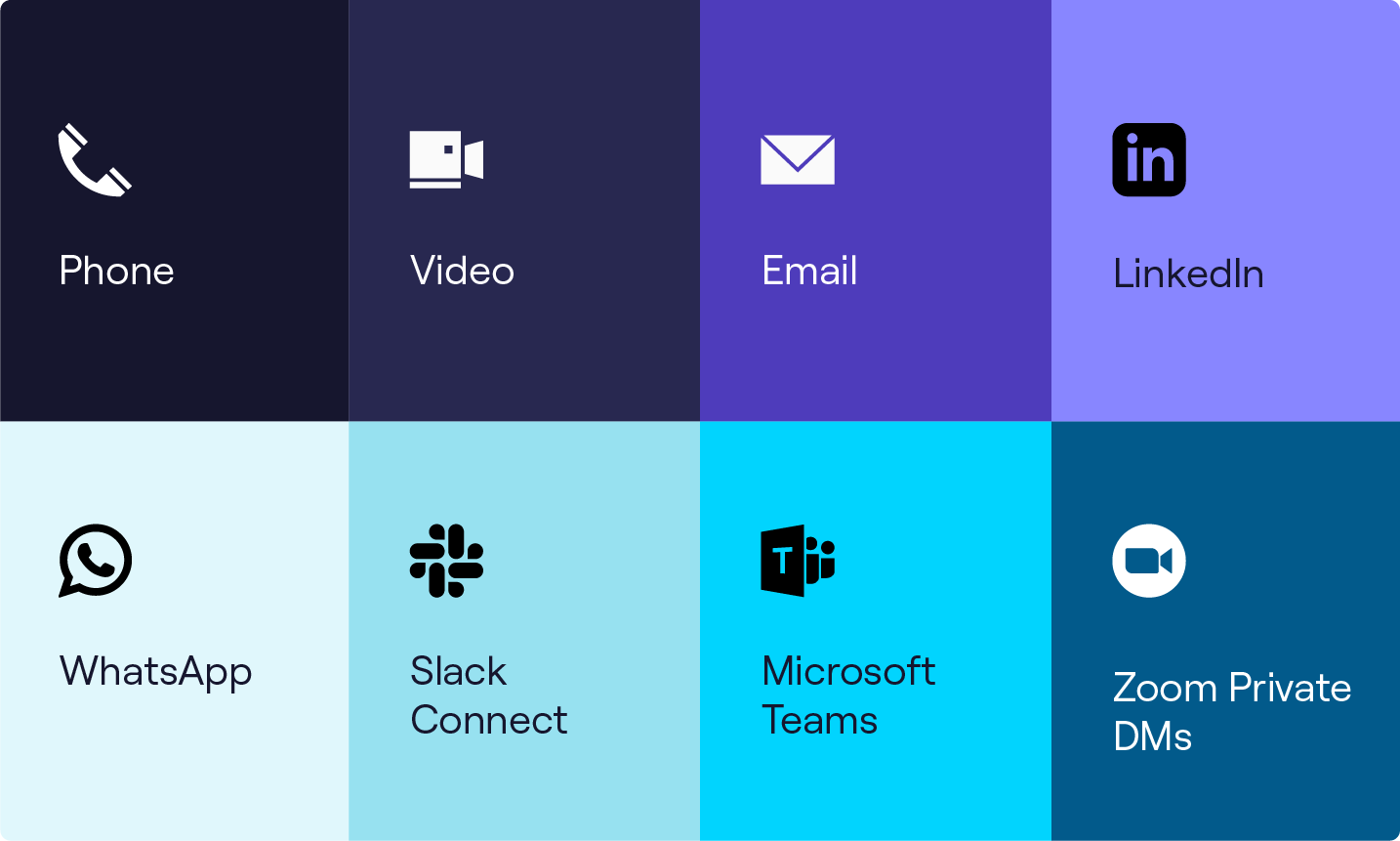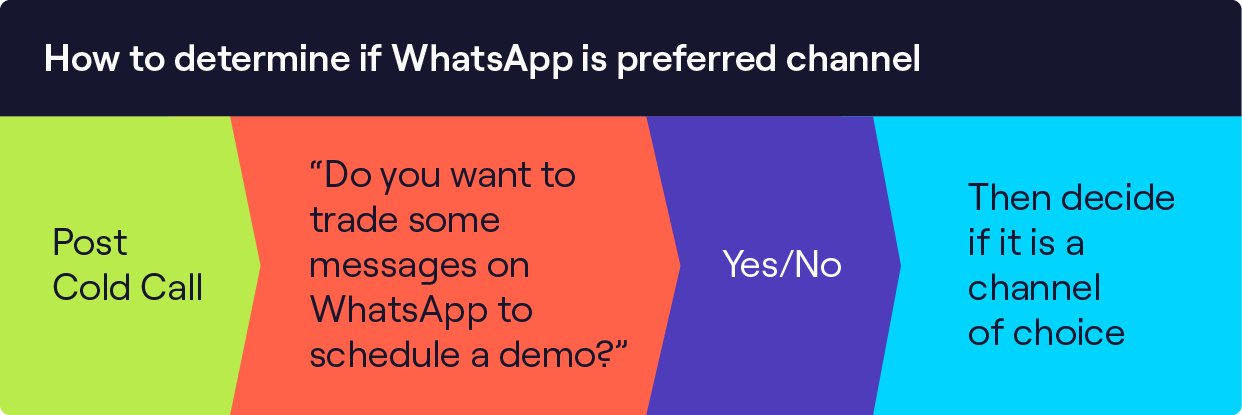What Are Sales Channels and Which Ones Should You Use?
‘Don’t call me on my personal mobile again.’
‘I prefer text over email.’
‘I prefer a social media LinkedIn message.’
I’m guessing these are some familiar phrases your B2B sales team has heard. And they’re important to consider.
Why?
Because they’re a reflection of how buyers like to be contacted. In other words, their choice of sales channel.
Now, here’s the truth.
There’s no clear playbook or brand identity which states which are the most effective sales channels.
Instead, it comes down to an understanding that every B2B sales customer is different.
Now, you might be wondering:
‘How can I come to this conclusion? And what strategies should I consider in my multichannel sales strategy?’
Well, you’ll find out in this article, where we’ll explore the many different types of sales channels and distribution channels.
Scroll 👇 to learn more.
Sales channels defined
First things first: what are B2B sales channels (sometimes known as distribution channels)?
It’s a term that refers to the various sales strategies a company uses to sell its products or services to customers.
These channels can vary widely depending on the nature of the business, the target market, and the industry.
Effective sales channel strategy often involves a mix of channels, tailored to your target audience’s specific needs and preferences.
What channels can sales teams use?
Now you know what sales channels are, it’s time to discover the many types of sales channel.
Here are the wide range of channels available to your sales team:
Sales reps will often use a mix of sales channels, including social media platforms, to achieve their objectives.
The emergence of new online sales channels from our list, like WhatsApp and Slack Connect, is especially important.
In today’s B2B sales world, the winners are those who think beyond traditional communication methods.
It’s easy to make this mix of sales channels part of your business model. Simply find out which online channels your leads prefer, and then engage them on those channels.
Which leads us to our next question...
Why are channel preferences important?
‘Do potential customers really care about the different channels? Can’t I just send emails, make sales calls, and hope for the best?’
Here’s the deal.
This mindset would have worked five, even ten years ago. But the customer experience has changed. It’s not as simple anymore.
Target audiences and potential partners have a huge choice of sales channels available to them.
Now, that’s not to say email and cold calling aren’t viable direct sales strategies. That would be an extreme viewpoint.
But what we’re getting at is that we’re in a digital age, more than ever before. So digital forms of communication, like LinkedIn (social media), Zoom, even Slack, have become increasingly popular sales and marketing channels. to increase profit margins.
Online platforms have become the best drivers of direct sales.
Jonathon Ilett, Cognism’s former VP of Global Sales, explains more in the clip below ⬇️
In other words, there isn’t such a thing as a ‘one-size-fits-all’ buyer anymore. The customer journey doesn’t follow a set, linear path.
So, sales teams have to get ahead of the curve and meet their customer base on their preferred forms of communication if they want to increase profit margins, whether it’s social media or even more traditional methods like trade shows!
This means focusing on a wide range of channels and their sales strategies.
In the long run, that’s the secret to getting higher response rates and hitting your sales goals.
Thomas Philip, Head of Sales at Mailmodo, told us:
“As the mechanisms and channels of outbound sales continue to evolve rapidly, it has become imperative to reach out to prospects through their preferred channel.
It helps establish a better connection rate with prospects and create a healthy pipeline that closes faster.”
This is especially relevant for today’s sales process. The time it takes to close deals has increased, which is a huge concern for sales team leaders.
For example, in a Gong study, the % number of deals that closed by the end of the year decreased from 69% to 61% between 2020 and 2022.
So, what does this mean?
Leaders and business owners must understand how, and where, B2B customers like to be contacted.
That’s how they can reach them in the right place and close deals faster.
This has a long-term impact on the quality of a team’s ability to multithread, especially in the post-demo stage.
Think about it for a second.
Most sales agents adjust their pitch when selling to different job seniorities or personas. But not many reps adjust the channel.
Diana Stepanova, Operations Director at Monitask, agreed:
“When reps engage customers on their preferred channels, they’re more likely to initiate meaningful conversations that lead to successful outcomes.
And from a leadership or wider team perspective, valuable insights into customer needs and preferences can be enhanced even further.”
Finally, think about the fundamentals of sales. It all comes back to building strong relationships and being human. This is a crucial part of the customer journey.
When your team is interested in sales channel preferences, they’re putting their potential customers first.
Jon Morgan, CEO at Venturesmarter, said:
“It can impact the quality of conversations. Customers are more likely to engage in meaningful conversations if they’re contacted through their preferred channels.
It’ll lead to stronger interactions and better direct sales relationships.”
So, what is the key takeaway from these insights?
Invest in understanding channel preferences, inside and out. Because it’ll lead to a positive domino effect.
A great customer experience leads to more sales, whether on social media platforms, on the phone, or on many other avenues.
How do you determine sales channel preferences?
This is the hard part!
How can you ensure sellers meet B2B customers in the right places?
Here are some tips:
1. It’s all in the data
It’s probably no secret to you, as a sales agent.
But the stats and figures will be your best friends here.
Morgan J. Ingram explained why:
“Your sales data will tell you what’s working and what’s not.
If you identify one channel that’s doing really well, because the response rates have been super high, amazing! Double down on that channel.”
For Jon, though, customer data is vital to improving the customer experience. He had this to say about customer data collection:
“Collecting and analysing data on customer preferences can help inform which channels are most effective for each customer.
Sales leaders can work with their teams to gather data on preferred communication methods and develop a strategy to optimise outreach.”
Thomas agreed, saying:
“We understand our ICP, and choose the most efficient channel for communication based on their preferences.”
Diana also agreed:
“Cross-channel analytics can help to uncover trends and insights into potential customers and their behaviour.
This can help to identify which channels are most effective in terms of conversion, engagement, and revenue generated.
A great way to start is by looking at the customer journey - what does it look like for those in your target audience?
What channels and platforms will customers likely use during their buying process, and how can sales reps engage them on these different channels?”
2. Use tools
We get it.
As a sales leader, your number one priority with anything that you’re testing or implementing is whether it will be an efficient use of your and your reps’ time.
There are so many potential sales channels available to your team. How do you know which ones to use?
The good news is that sales tools can do the hard work for you.
Jon said:
“To prospect on multiple sales channels without impacting on efficiency, sales teams should use technology and automation tools to streamline communication across those channels.”
Diana agreed:
“Automation can help with outreach efforts by providing personalised messages and scheduling follow-ups on different channels.”
Now, automation tools have caused a debate. Some believe they’re dying out because they create generic templates. Whereas others think they still have a place in the sales process.
But at the end of the day, they will help your team speed up the sales cycle.
Rory Sadler, CEO and Co-Founder at trumpet, gave his two cents on this:
“Tools have a significant role to play in forming the customer experience. But there should be more manual steps in the sequence.
So, even though it’s an email, you need to go to that email, do the 5 minutes of research, and then personalise it. Not just filling the template in with names and hitting send.”
If you’re interested in finding out more about tools, and specifically AI ones (generative AI, predictive AI, etc), click here to find out how to write cold call scripts in 15 seconds.
3. All you have to do is ask!
If you don’t ask, you don’t get.
If anything, asking your prospect how they like to be contacted shows an understanding. It humanises the SDR and makes them stand out from others.
Here’s an example of how your reps could ask if WhatsApp is a preference:
Thomas reminded us of something important when it comes to using single sales channels like WhatsApp:
“It’s crucial to follow basic etiquette, such as keeping conversations within office hours when reaching out.”
The bottom line?
When adopting a multichannel sales approach, follow industry best practices, and consider using a CRM system like Salesforce or HubSpot if you haven’t already.
This will result in more customer loyalty, increased conversion rates, improved direct selling and undoubtedly, increased sales pipeline.
Sales channels: the last word
To finish this article, we wanted to summarise why sales channels are so important.
Here’s an insight from Dan Gray, CEO and Co-Founder at Vendry:
“Choosing and operating the right communication channels for your sales efforts is incredibly paramount and requires a strong understanding of the customer you sell to.
Without testing and adapting to how your customer responds to messages, you’ll never unlock the right playbook for increased response rates.”
Looking for more direct sales insights which will result in more customer loyalty, customer insights, improved sales metrics and much more? Listen to Cognism’s Why Did It Fail? podcast 👇


-png-1.png?width=2988&height=1146&name=Why%20did%20it%20fail%20Podcast%20(1)-png-1.png)
/Cold%20calling%20strategy/cold-calling-strategy-card.webp)

